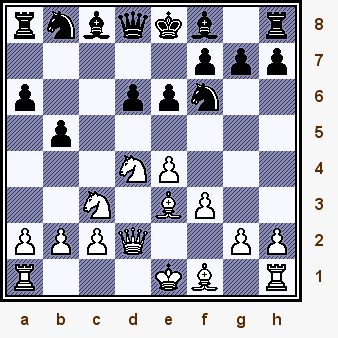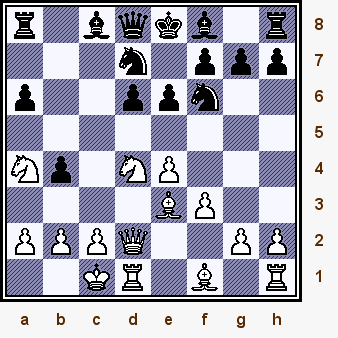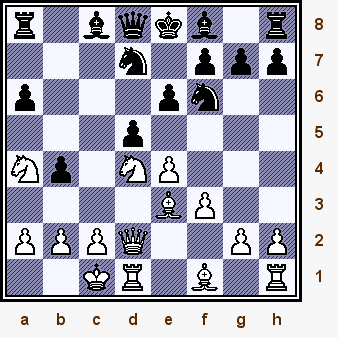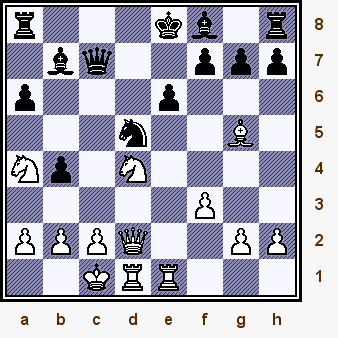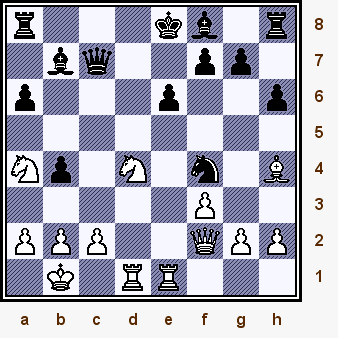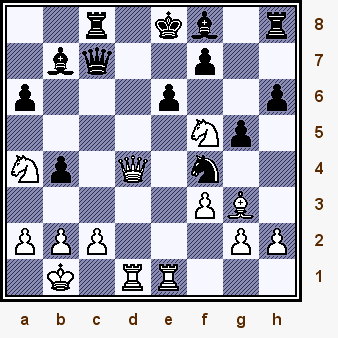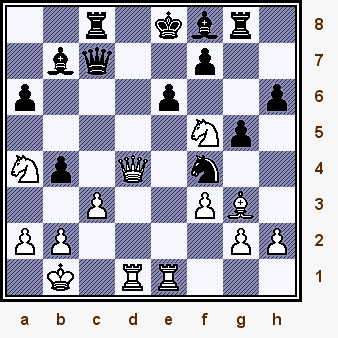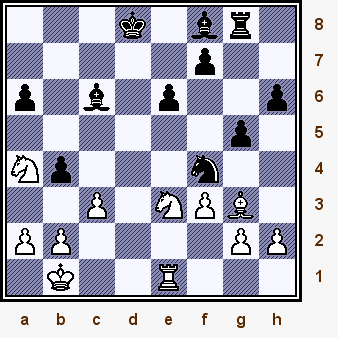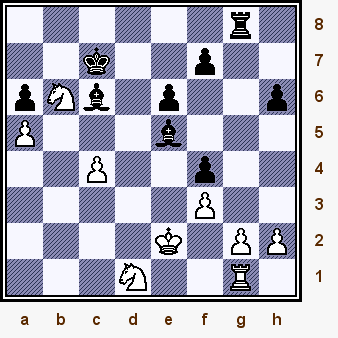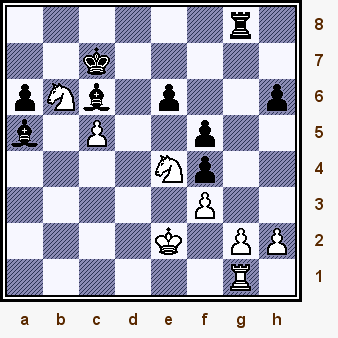[B90] The World Chess Championships / DRR Tournament (WCh-FIDE) San Luis, ARG; (Round No. One / R#1), 28.09.2005. |
|
|
My "Game of The Month" for the period for November, 2005, (Cf. TWIC # 569.)
** ** ** ** ** ** ** ** ** ** ** ** ** ** ** ** ** ** ** ** ** ** ** ** ** ** ** ** ** ** ** ** ** ** ** **
Unless you have been terribly busy, undoubtedly {by now} you have heard that Topalov won the (FIDE) World Chess Championships in San Luis, Argentina. (Sept. - Oct; 2005.) [ The ChessBase story, with details, pictures, and links.]
In
the first half, Topalov scored a blistering 6.5/7 ... which also is one
of the best Performance Ratings of all time ...
especially at this level. (Perhaps only Fischer's 6-0 demolition of both
Taimanov and Larsen ranks ahead of this feat.)
Anyway, this game - being the start of Topalov's amazing run - cries out to be examined. Also - I have not really analyzed that many games by Topalov for my "Game of The Month" column, so it was definitely time to feature this player. (Congrats to GM V. Topalov, he IS the new world's champion, his play sets a standard that all other players can aspire to.)
Note: I make several references to the analysis by GM S. Shipov, the link can be found in the analysis after White's 20th move.
1.e4
c5; 2.Nf3 d6; 3.d4 cxd4; 4.Nxd4 Nf6; 5.Nc3 a6;
(Controls b5.)
The Najdorf Variation.
Others tried it before him, but it was ultimately Bobby Fischer who was responsible for making this system the respected opening line that it is today. (Another World Champion, GM Garry Kasparov, also used this opening - extensively - to win whenever he played the Black pieces.)
[ After the move of:
5...g6;
{D?} we have the Dragon
Variation, which is not used much {today}
at the highest GM levels. (One
happy exception would be the games of Anand - Kasparov; from
the World Championships in New
York, in 1995.) ]
6.f3!?,
(Supports the center.)
A super-modern move, that was once
considered to be nearly worthless, or
at least completely harmless.
However, today this is not only played
by the top players, it is also fully
accepted and respected.
(Generally,
this is an indication that White wishes
to play "The English Attack," where
the first player plays f3, Be3, Qd2.
Then the first player can choose
between either g4, or the immediate
0-0-0. Another cool aspect is that
this variation
can
be played against
almost any Sicilian set-up that the
second player might choose.)
I think that Leko's move order, (6.f3, and not 6.Be3); is a refinement of his opening repertoire. Apparently, Leko does not want to play the lines of 6.Be3, Ng4!?; as he used to play these lines as Black. With a small change in his move order, he completely eliminates any possibility of this particular line occurring in this game. (This is also good from a practical viewpoint - less time is spent studying the opening, as a professional player, you would not have to bother studying lines that had no chance of actually appearing in your game.)
[ For close to (or over) 30 years, the
main line used to Bg5 here for White.
(It was featured in the World's
Championship
Match in 1972 in Reykjavik, Iceland ...
between GM Robert J. ("Bobby")
Fischer and GM Boris Spassky.)
A more current example would be:
6.Bg5 e6; 7.f4 Be7; 8.Qf3 Qc7; 9.0-0-0 Nbd7;
10.g4, (wing pressure)
Originally - this was the main
continuation for White. However,
it was later supplanted by Bd3,
which was considered to be best
{or the sharpest} for more than
twenty years.
Now the wheel has turned full circle, and 10.g4 is once more considered to be the main line for White.
*** *** *** *** *** *** *** *** *** *** *** *** *** *** *** *** *** *** *** ***
( For the move of: 10.Bd3!?,
"+/=" {D?} please see any good, opening
reference
work like ECO or John
Nunn's books on this opening.
For example, [ See MCO-14, page # 250;
columns # 10 and col. # 11, and all
appropriate notes for these lines. ] )
*** *** *** *** *** *** *** *** *** *** *** *** *** *** *** *** *** *** *** ***
10...b5; 11.Bxf6 Nxf6; 12.g5 Nd7;
13.f5!, "+/="
White has a strong position.
(Pressure ... and/or the initiative.)
I scoured the database, and there
were literally hundred of examples.
The best one that I could find was:
GM Lembit Oll (2645) -
GM Matthew Sadler (2665);
ICT / Masters Open
/
Koge, DEN; 1997. (1-0, 64
moves.)
[ See MCO-14, page # 250;
column # 07 and all corresponding
notes for that column.
Especially
see note # (f.). Also column # 08,
and notes # (g. through i.) as well. ]
See also the excellent work: "The Complete Najdorf,
6.Bg5," by GM John Nunn. (Chapter # 01)
First published by Batsford in 1996,
and then reprinted in the U.S. (1997) by I.C.E. ISBN: # 1-879479-45-1
(This book is already a little dated,
however it is still one of the best
manuals available on this opening.
It is a MUST for all serious students
and aspiring masters who wish to
try their hand at this complex
and difficult opening system!)
**************************************************************************************
Normally, the move Be3 and the move f3 on move six are nearly interchangeable, but not always.
For the continuation of:
6.Be3 e6; 7.g4 e5!?;
See the amazing GM
fight: J. Polgar - R.
Kasimdzhanov;
(FIDE) World
Championship Tournament /
San Luis, ARG; 2005. (1-0)
If you have ChessBase, (or Fritz)
make sure you download ...
"The Games Considered" file,
by
clicking on the link in the first box
at the top of the page.
(This game
is THOROUGHLY annotated!) ]
6...e6;
(Hits d5 / blocks in the QB.)
A permanent commitment - for the
second player - about what he plans
to do about the center. {long-term}
(Black can play either ...e6; or ...e5;
or delay this decision for the
foreseeable future.)
Nowadays, perhaps in imitation of players like Garry Kasparov, the highest-rated GM's almost invariably choose 6...e6; in this position.
[ Black can also try:
("=") 6...e5!?;
7.Nb3 Be6; 8.Be3 Be7; 9.Qd2 0-0;
10.0-0-0,
"+/=" 10...Nbd7;
but White maintains a small edge,
with the better position.
(A little
more space and the first player also controls d5.)
See the GM contest:
Peter Leko - Peter Svidler
ICT / Masters
(Corus "A")
/ Wijk ann Zee, NED; 2005. (57)
(White won an interesting game,
1-0, in fifty-seven total moves.}
****************************************************************
Not to be recommended would be:
(</=) 6...g6!?;
('?!') 7.Be3,
"+/=" {D?}
as Black could be just a tempo
down in all the key variants of the
Yugoslav Attack
of the Sicilian
Dragon. (The move ...a7-a6; is
not necessary in many of the main
lines and key variations.)
A good example would be:
GM Mohammed Al Modiahki
(2570) -
IM Simon Williams (2461);
ICT / Masters /
ACT Open (R6)
/
Amsterdam, NED; 2005. (1-0, 33 moves.) ]
White can play many different tries
here, but his next move is a key part
of his whole opening plan.
7.Be3 b5!?;
[space + wing attack]
An extremely sharp advance, that is
also a little bit risky.
(Apparently GM
V. Topalov is not adverse to taking
a few chances in this tournament.)
[ Perhaps a little safer would be:
(>/=) 7...Nbd7; 8.Qd2 Qc7;
9.g4 h6; 10.0-0-0,
"+/=" 10...b5;
"~"
when White has a slight edge, but
Black has reasonable play.
GM J. Speelman - GM A. Sokolov;
/ ICT / World Cup
Belfort, FRA; 1988. (1/2) {A tough draw in forty moves.}
]
8.Qd2!?,
(Maybe - '!')
{See the diagram given, just below.}
This move is considered by many
to be the most accurate try for White
(in this position).
************************************
|
|
************************************
rnbqkb1r/5ppp/p2ppn2/1p6/3NP3/2N1BP2/PPPQ2PP/R3KB1R b
I think 8.g4 is perfectly playable, but it has received a few setbacks as of late. ("8.Qd2!" - GM Sergey Shipov.)
[ Veselin has also played against 8.g4, and not without some measure of success.
For example:
8.g4 h6!?; 9.Qd2 b4!?; 10.Na4 Nbd7; 11.0-0-0!?
Ne5;
This is good for Black, as was
the move, 11...Qa5.
12.Qxb4!? Bd7; 13.Nb3? Rb8;
14.Qa3?! Nxf3; 15.h3 Nxe4; 16.Be2 Ne5!;
17.Rhe1 Qc7; 18.Bd4 Nc6;
19.Bc3!? d5; 20.Nbc5 Qa7; ("-/+") 0-1
GM Vladimir Kramnik
(2754)
- GM Veselin Topalov
(2757);
ICT / Masters
(CORUS "A") /
Wijk aan Zee, NED; (R2) / 16,01,2005.
********************************************************************
White can also play the precautionary
move of a3, and avoid any time-loss
or
embarrassment of his Knight.
For example:
8.a3!? Bb7; 9.Qd2 Nbd7; 10.g4 h6;
11.0-0-0, "~"
("+/=")
when White might have a small
edge in this position ... but if the
first player does have
an advantage, it is a very minimal one.
GM Peter Leko - GM Loek van Wely; /
ICT / Masters (CORUS)
Wijk aan Zee, NED; 2000. {Drawn, 1/2, in 28 total moves.} ]
8...b4;
('!' or '!?')
-- tempo
This gains time and immediately
displaces White's Queen Knight
as well.
(Although the hanging
button on b4 could be something
of a liability.)
[ By playing 8...Nbd7 here, Black would transpose back to the (older) main lines.
For example:
"=" 8...Nbd7; 9.g4 h6;
10.0-0-0,
"+/="
10...Bb7;
"<=>" (Q-side) {Diagram?}
with good play for both parties.
*** *** *** *** *** *** *** *** *** *** *** *** *** *** *** *** *** *** ***
One of the best examples in the
games db, with both of the
participants being
top-rated GM's,
would have to be:
GM V. Anand (2781) -
GM G. Kasparov (2812);
/
ICT / 16th Super-GM
/ R # 10
/ Linares, ESP; 1999. (1/2, 50
mvs.) {A tough draw in fifty moves.}
[ See (also) Informant, # 75, and game # 210. ] ]
9.Na4,
('!' - GM Sergey Shipov)
It looks strange to purposely place
a Knight on the edge of the board
like this ...
(Obviously - Nb1 is not
even a move that falls under any
serious consideration by White.)
[ However, after the moves:
(</=) 9.Nce2!? e5!; 10.Nb3,
"~" "+/="
(etc.)
Black should have no real problems
from this position.
(At least this is the judgment of current opening theory.)
GM V. Kramnik (2753) -
GM V. Topalov (2778);
/
ICT / The M-Tel Masters
/ Sofia, BUL;
/ (R #10), 12,05,2005. /
(0-1, 34
moves.)
{Black won a sharp game in a total
of just thirty-four moves.}
****************************************************************
Fritz also finds the continuation:
(</=) 9.Nd1!? e5; 10.Nb3
d5!; "~" {Diagram?}
when Black seems to have no real
problems, and may
have already
equalized ("=") here. ]
9...Nbd7;
('!' or '!?')
Topalov gambits a Pawn, if White
takes the button, Black seems to
have no problem generating any
counterplay. This idea is relatively new to opening theory, the games
database indicates that Black would
normally play 9...d5; in this position.
[ But not:
</= 9...a5?; 10.Nb5,
'±' {Diag?}
as White already has a very
powerful initiative. ]
10.0-0-0,
(King Safety)
(TN?)
{See the diagram given, just below.}
Castling here is good, and is in keeping
with standard, accepted opening
principles. However, moves like c4 or
Bd3 were (also) worth some thought.
************************************
|
|
************************************
r1bqkb1r/3n1ppp/p2ppn2/8/Np1NP3/4BP2/PPPQ2PP/2KR1B1R b
Believe it or not ... as best as I can determine ... this very logical move is brand-new to opening theory.
[ But definitely not:
</= 10.Qxb4?! d5; 11.Qd2 dxe4;
"<=>"
as White's center has begun to
crumble, this cannot be the way
for the first player to maintain an
advantage out of the opening. ]
10...d5!?;
{See the diagram given, just below.}
Normally it is good to break in the
center, however here Black is just
a tad under-developed, so there
is a certain amount of risk connected
to this move here.
************************************
|
|
************************************
r1bqkb1r/3n1ppp/p3pn2/3p4/Np1NP3/4BP2/PPPQ2PP/2KR1B1R w
This is definitely a key position - for both players - for the opening phase of the game.
[ Interesting was: 10...Qa5; in this position for Black. ("~" or "=/+") ]
11.exd5,
('!' - GM S. Shipov.)
At first glance, this seems like the
indicated move. However, Fritz found
another continuation that I thought
might be playable.
[ After the continuation:
11.Nb3!? Qc7!?; "~" (Maybe -
"=/+")
both sides have many paths to
explore from here. ]
11...Nxd5;
12.Bc4, (Threat?)
White develops a piece, and tries to
increase the pressure.
(If Black
ignores White's last move, White
will play BxN/d5, giving Black a
very weak, isolated QP.)
[ Also possible was:
12.Nb3,
focusing on the c5-square.
(This
move is the first choice of several
different chess programs, and it
also makes a certain amount of
sense, certainly it was worth a look.) ]
12...N7f6;
13.Bg5 Qc7;
Black escapes the pin ... and hits
the Bishop on the c4-square here.
14.Bxd5,
(Giving up the cleric?)
In order not to lose a tempo, White
simply exchanges off the Bishop
in this position.
(Maybe Bb3 was playable for White in this
position.)
[ But not:
</= 14.Qe2?! h6; 15.Bh4 Nf4;
16.Qf1 Bd7;
"=/+"
when Black already might have
an advantage in this position. ]
14...Nxd5;
15.Rhe1 Bb7; {See the diagram given, just below.}
Thus far, all of Black's moves
have been harmonious.
(White's
moves have not been bad, either.)
************************************
|
|
************************************
r3kb1r/1bq2ppp/p3p3/3n2B1/Np1N4/5P2/PPPQ2PP/2KRR3 w
This is a good place to stop, and try to assess this position.
*** *** *** *** *** *** *** *** *** *** *** *** *** *** *** *** *** *** *** *** *** *** *** ***
After White's next move, the
opening tension has reached a
crucial apex.
(White's next move
is also the most energetic, and it
also received an exclam in
several newspaper columns, as
well as from GM S. Shipov.)
16.Qe2! Qd6!?;
(Is this best?)
Black protects the e6-square, but
Fritz also wants to look at 16...Qc8;
in this position.
[ But definitely not:
</= 16...h6?; ('??')
17.Nxe6! fxe6;
18.Qxe6+ Be7;
19.Bxe7!,
This wins for White, as does the
move of RxN/d5.
( White also wins with: (</=)
19.Rxd5!? Bxd5; 20.Qg6+ Bf7; 21.Rxe7+! Qxe7;
22.Qc6+, etc.
("+/-") with an obvious advantage. {The
Rook on a8 falls with check.} )
19...Nxe7;
(Looks forced.)
No choice here, if you play
19...QxB/e7?; then simply 20.Qg6+, and bye-bye BQ.
20.Nb6! Rd8;
(forced?)
This appears to be the only
move for Black, if 20...Rc8!?; then simply 21.Qd7+!,
will
carry the day for White.
21.Rxd8+ Qxd8;
(Probably forced.)
22.Rd1 Qc7;
23.Rd7 Qf4+!?;
Seemingly a reasonable try, the
only alternative was for Black to
surrender the Queen
at this point. (Which is also hopeless.)
24.Kb1 Qf6; 25.Rd8+!, "+/-" and mate on d7 next move. ]
17.Kb1,
(Getting of the c-file.)
Before beginning prolonged operations
against Black, Leko first wants his King
on a slightly safer square here.
(One
writer stated {that he thought}
that this
move is very much in keeping with GM
Leko's style of play - and I concur.)
[ Also worth looking at was Fritz's
choice of:
17.f4!?,
with the idea
an immediate f4-f5.
(White tries to
crack open lines as quickly as possible
while Black's King remains in the
middle of the board.) ]
17...h6;
18.Bh4 Nf4; (Hits the WQ.)
This is good, and a natural response
to White's last move, which left the
f4-square unprotected.
[ After the moves:
(</=)
18...Rc8!?; ('?!')
19.Bg3 Qe7; 20.Nf5! Qf6;
21.Nd6+ Bxd6; 22.Bxd6,
"+/="
Black may experience some
problems - because his King is trapped in the center. ]
19.Qf2 Qc7?!;
(Maybe - '?')
{See the diagram given, just below.}
At first, this seems to be a perfectly
normal play for Black in this position.
However, this move is an error,
(albeit a seemingly slight miscue);
and one that could have cost GM
Topalov the game ...
although the
refutation is not easy to find, and
has many deep, and well-hidden
aspects to it.
************************************
|
|
************************************
r3kb1r/1bq2pp1/p3p2p/8/Np1N1n1B/5P2/PPP2QPP/1K1RR3 w
Just about every program that I tested this game on saw a fairly large jump in the scores of the evaluations of the positions after Black's nineteenth move. Additionally, the boxes were pretty much united in their 'opinion' that 19...Nd5 was forced for Black.
[ Black should have probably tried:
>/= 19...Nd5[]; ('!')
20.Qe2!?,
"+/="
White can also try Nf5 or Bg3
in this position.
(Also good was: 20.Bg3 Qd8; 21.Qe2, "+/=" with a small edge for White.)
20...Rc8;
"~" when White still might be better,
but Black has chances to defend.
(In any case, this was much better
than what occurred in the game!) ]
20.Nf5?!,
(Maybe even - '?')
Missing a golden opportunity.
[ White had a chance for a brilliancy here with Nb6!!
For example:
>/= 20.Nb6!! Rb8;
(Forced?)
There might not be anything
better here for Black.
( </= 20...Qxb6?; 21.Nxe6! Qxe6!?; 22.Qa7!!, ("+/-") - GM S. Shipov )
21.Nf5 Bc6;
Otherwise, Rd7 is next.
22.Qd4! Rg8;
This looks forced.
****************
( Or 22...Ng6; 23.Bg3 Qxb6; 24.Qxb6 Rxb6;
25.Bc7, "+/-"
Analysis by - GM S. Shipov. (http://www.chesspro.ru/events/sanluis05-1en.shtml)
)
(Not </= 22...Qxb6??; 23.Qxb6 Rxb6; 24.Rd8#.) {A.J.G.}
****************
23.Nc4,
Gaining control of d6.
(Also possible was: 23.Bg3!?, in this position for White.)
23...g5; 24.Bg3 b3!?;
Fritz's "wiggle" move, Shipov
(instead) gives the immediate
move of ...Rd8 here.
(Or 24...Ba4!?; 25.b3 Bc6; 26.Bxf4 gxf4; 27.Qf6!, "--->" - ChessMaster, 10th Ed.)
25.axb3 Rd8; 26.Qf6!!,
(best)
The most accurate move here.
( GM S. Shipov gives instead: 26.Ncd6+!?,
(in a similar position)
which also
should win for White. (See the link
given just above.) )
26...Rxd1+;
This (also) looks to
be forced for Black.
( </= 26...Be7?; 27.Ng7+, etc. )
27.Rxd1 Bd5;
This appears forced.
(
</=
27...exf5?;
28.Bxf4 gxf4!?;
29.Ne5,
"--->" ("+/-")
'+11.47' - Fritz
when White's threats cannot be
defended against.
(Perhaps the
typical line that my friends try
here is:
29...Bd5!?; 30.Rxd5, Rg6?!;
{Fritz tries
30...Bd6; here - but
this is only "give-away."}
31.Rd8+! with mate (on f7) next move. )
)
28.Nce3 Bb7; 29.Nxh6 Bxh6;
This looks forced, in any case,
the other move (29...Rg7),
looked
far too clumsy to be considered as
a realistic alternative here.
30.Qxh6 Ke7!?;
31.Ng4! Rg6;
32.Bxf4! gxf4[];
33.Qh4+ Ke8[];
This is definitely forced.
(If 33...Kf8??;
then 34.Rd8+. And if 34...Kg7??; then 35.Qh8# would be mate.)
34.Nf6+ Rxf6[];
(No choice.)
This is definitely forced, if
34...Kf8?; then 35.Rd7,
was a resignable position
for Black.
("+/-"
The threat is now
simply Qh8+, and mate next move.)
And 34...Ke7??; 35.Nd5+,
drops the
second player's Queen.
35.Qxf6,
"+/-" White wins the exchange ... AND
the attack continues.
(This actually
represents a fairly substantial
improvement over the continuation
suggested by GM A. Shipov ... and
others. Now if 35...Bd5; then 36.Rd4.) ]
The next couple of moves appear
to be forced (or best) for both sides.
20...g5;
21.Bg3 Rc8; 22.Qd4!?, (hmmm)
{See the diagram given, just below.}
This looks natural, and immediately
attacks the Black Rook on the h8-square here.
************************************
|
|
************************************
2r1kb1r/1bq2p2/p3p2p/5Np1/Np1Q1n2/5PB1/PPP3PP/1K1RR3 b
The tension in the position is rapidly building to a second crescendo.
[ The boxes want to look at: 22.Rd2!?; "+/=" or even the odd-looking 22.Ka1!?, "~" in this position for White. ]
22...Rg8;
(Box.)
This is forced, 22...Rh7 was way
too awkward to be a serious
candidate move for Black.
[ Definitely not:
</=
22...Qxc2+??;
as after
the simple move of: 23.Ka1,
"+/-"
Black can NOT simultaneously
defend against two threats here.
(Qd7 mate, and also QxR/h8.) ]
23.c3?,
(Ugh!) [>/= 23.Qd2.]
{See the diagram given, just below.}
There is no doubt in my mind that
this is an error, now White is forced
into an endgame that is inferior for
him.
- Further, White gets busted
pawns and Black's two Bishops
could definitely be a factor as well.
************************************
|
|
************************************
2r1kbr1/1bq2p2/p3p2p/5Np1/Np1Q1n2/2P2PB1/PP4PP/1K1RR3 b
Just about anything was better than
this.
(All the programs notice a huge
jump in their scores of the position
after this move. '?' - GM S. Shipov.)
[ >/= 23.Qf2 h5!?; "~" ]
Black's next move is thematic.
(Material is forced off the board,
Topalov relieves the pressure, and
... goes right into an ending.)
23...Rd8;
('!')
24.Qxd8+[],
Now White has no choice.
[ But
definitely not:
</=
24.Qe3? Bc6; 25.Nb6 bxc3;
26.Rc1 Bb4;
"/+"
when Black is better. ]
The next few moves are all pretty
much forced.
24...Qxd8;
25.Rxd8+ Kxd8;
Black - despite not having castled -
experiences a sudden change of
fortune, and is doing well.
Now that the e-pawn is no longer
pinned, White must save the Knight
on the f5-square here.
26.Ne3 Bc6;
(The most active.)
{See the diagram given, just below.}
Black's Bishops, which have not
been much of a factor thus far in
the game, now prove decisive.
Meanwhile, White's Knight on the
edge of the board now finds itself
in dire straits. (Maybe - '!')
************************************
|
|
************************************
3k1br1/5p2/p1b1p2p/6p1/Np3n2/2P1NPB1/PP4PP/1K2R3 w
This would be a good place to take a look at the game ... and try to figure out what is happening here.
27.Nb6[],
(Forced.)
Not much choice here for White.
[ But not the very gross:
</= 27.b3? Bxa4;
28.bxa4 bxc3; 29.Kc2 Bg7;
"/+" (Maybe "-/+")
when Black is probably winning. ]
27...bxc3;
28.bxc3 Bg7; 29.Bxf4!?, (Probably - '?!')
I hate to kick a good man when he
is down, but this looks like a bad
choice ... for a number of reasons.
[ # 1.)
White surrenders his last
Bishop here. (The Black pair of
Bishops now becomes a truly
awesome duo.)
# 2.) White opens the g-file for the
Black Rook on g8.
# 3.) The Knight on e3 loses
even more time ... and is also (now)
driven to a really bad square. ]
[ (>/=) 29.Kc2 Kc7; 30.Nec4 h5; "=/+" ]
29...gxf4;
30.Nd1 Bb5!;
This traps the Knight on b6, now
if a4 or c4 - if Black chooses to do
so - he could win a Pawn with
the simple play, ...Kc7.
31.a4!?,
(hmmm)
White's game is entering the last
dying contortions, the remainder
of the game is almost too painful
for me to watch.
(Except - in my
role as annotator - I am not allowed
to avert my gaze!)
White's Knights are clumsy pieces
in this position ... and "step on each
others' toes" ...
if you will allow this
general, if imprecise, analogy.
[ Maybe a little better was:
(>/=)
31.c4 Be8!;
32.Re2 Kc7; etc.
("-/+")
(But Black should have no real
problems gaining the full point.) ]
The next few moves are all pretty
much best or forced.
31...Bd3+;
32.Kc1 Kc7; 33.a5 Bh8; (Why this move?)
This move continues the attack on
the c3-pawn, while clearing the
g-file ...
so that the Black Rook now
attacks the WP on the g2-square.
(This is the safest square for the Bishop,
but Fritz's 33...Bf6; was also quite
good for Black as well.)
34.Kd2 Bb5;
35.Rg1 Bc6;
Now the threat is ...BxP/f3; taking
advantage of the pin on the file.
White chooses a move that protects
the f-pawn, if Leko starts letting go
of a bunch of buttons,
then he may
as well tender his resignation here.
(Fritz recommends 36.Nf2, instead.)
36.Ke2 Be5!?;
This is OK ... (but)
[ The move of
>/= 36...Rg5!; "-/+"
{D?}
looks like a definite improvement
for Black. ]
37.c4!?,
(hmmm)
{See the diagram given, just below.}
I see no point in criticizing White's
moves at this point ... Peter Leko
is dead lost, and nothing is going
to change that.
************************************
|
|
************************************
6r1/2k2p2/pNb1p2p/P3b3/2P2p2/5P2/4K1PP/3N2R1 b
White's once proud position ... has basically been reduced to rubble.
[ Maybe slightly better was:
(>/=) 37.Nc4 Bf6!?;
38.Nd2 Rg5!; 39.Ne4 Bxe4; 40.fxe4 Rxa5;
"-/+"
(41.Rf1, Be5; etc.)
although I am
sure that Topalov would still have
won without
too much difficulty from
this position. ]
Now the move of 37...Rg5 is the first choice of Fritz 8.0 here.
37...Bd4;
38.Nf2 Bc3!?; (hmmm)
This is good, (enough); although the
move of >/= 38...Rg5!; (again) is probably
the most precise play for Topalov in
this position.
(I watched this game on
the Internet, Black was pretty short of
time at this point in the struggle.)
As the computer clearly shows, if
Black wanted to play his Bishop to
attack the a5-square, he had to
avoid the c-file.
(E.g., >/= 38...Bc5; with the idea of
39...B/c5-b4. "-/+")
39.Ne4?!,
(Really ... probably - '?')
Normally - my policy is that once a
player has a lost game, that I don't
criticize how they choose to end their
suffering or comment on minor mis-steps in their play. However, here the
difference between this move (and
the correct one) is simply too great
to ignore. (At least three points,
according to both Fritz and Shredder.)
Another thing to consider, is that a tricky tactic might create some badly needed counterplay, especially in the confusion of a time scramble. However, precisely because Leko was short of time here may have been the reason that he did not find the best defense.
[ Best for White was: >/= 39.Rc1!; "<=>" {Diag?} but Black should still prevail. ("-/+")
{The Rook move is a preface to the
idea of Nd5+!, PxN; PxP/d5,
winning
the Bishop on c6.
Black must play
cautiously to prevent concept this
from becoming a reality and causing
a
major stumbling block on the road
to the win.} ]
39...Bxa5;
40.c5!?, [ Best ... or an error?
('?')
]
Seemingly the simplest, and the
last move of the time control.
[ Fritz recommends (instead) the
following continuation:
(>/=)
40.Na4 Bxa4; 41.Ra1 Rxg2+;
42.Kf1 Rxh2; 43.Rxa4 Kb6;
and Black should still win.
("-/+")
{However, the difference between
this line and the one chosen in the
game is nearly two full points ... so
maybe there is something to this.} ]
40...f5!;
"-/+" (-
4.31, Fritz 8.0)
(White Resigns, 0-1) {Final
diagram ... just below.}
A well-played ending by Topalov,
although there are aspects of this
contest that are obviously far from
being perfect.
(A game to keep the
analysts busy for many years to
come? Probably so!)
************************************
|
|
************************************
6r1/2k5/pNb1p2p/b1P2p2/4Np2/5P2/4K1PP/6R1 w
And while this amazing first-round struggle might be far from perfect, I find it the perfect representative of Topalov's play in this event. Daring, gutsy, and - at times - even a little bit gritty. Yet magnificent, bold ... and fighting down to the last Pawn!! (This is how Topalov played nearly every game in this event.)
Make
sure to read the excellent story
of this round on the CB website.
A hearty hurrah ... and three cheers for the new World Champion ... GM Veselin Topalov!!!!!!!!!!
Copyright (c) A.J. Goldsby, 2005. All rights reserved.
0 - 1
-
The chess analysis for this feature was prepared with the excellent programs, ChessBase 8.0 and ChessBase 9.0. [purchase]
-
The HTML was generated and refined with several different programs ... then polished for this page with MS FrontPage.
-
The diagrams for this column were prepared with the excellent little program, Chess Captor 2.25.
